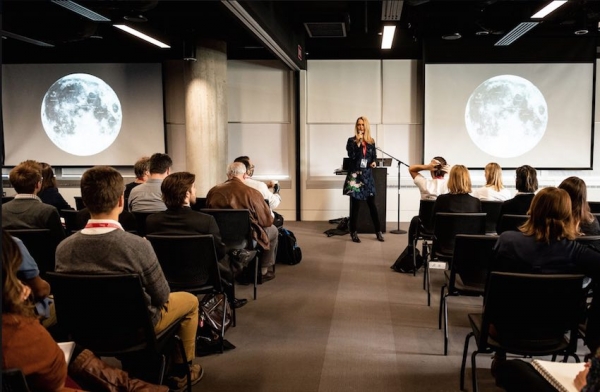The 2015 discovery of water on Mars, an essential for life on Earth, sparked theories of thriving Martian life. Ideas of interstellar travel to find extracellular beings were suddenly within reach. The second Montreal Space Symposium on Oct. 18 to 19, offered a forum for the future of space exploration, where speakers shared their passion for the next frontier.
Surface formations on Mars indicate that water may have swept up sediment and debris, before being flushed underground and sequestered away for billions of years in lava-formed rock passages. These Martian lava tubes now serve as stores for icy water and would provide a protective environment to microbes that may may exist within the rocks. These possible alien microbes would explain the persistent traces of methane in Mars’ atmosphere.
The Martian subsurface matches Earth’s own, where a thin film of water lies in lava tubes between ice and rock. Despite this harsh environment, Earth’s microorganisms thrive in large populations in lava tubes at oxygen concentrations very similar to those on Mars. They have adapted to using iron or other inorganic compounds as sources of energy.
“What this tends to indicate to us is that there could be a broad range of metabolisms as well as survival strategies,” Brady O’Connor, a Master’s student in the Department of Natural Resource Sciences, said in an interview with The McGill Tribune. “From a habitability standpoint and an astrobiology standpoint, this is encouraging.’’
Samples of these Earth-residing microbial communities reveal a diverse variety of organisms, providing an encouraging sign for the existence of similar life on Mars.
Theorizing life via analogy is promising, but scientists at the Space Symposium were eager to discuss how to find real evidence of life on Mars, which would be no easy task.
Such a mission would first require aerial surveillance for laval chutes into which robots could be lowered. After making it underground, there are more challenges. The uneven and unpredictable terrain of the caves could shred the wheels of the exploration rover in minutes. To circumvent the difficult geography, the mission would need to use robots that hop or rovers better adapted to the terrain.
Mars is only one of many planets to explore, however, and Andrew Higgins, associate professor in mechanical engineering, has set his sights on interstellar flight.
The bulk of stars and exoplanets surrounding Earth is at least 10 lightyears, or 100 trillion kilometres, away. Speed aside, it would be impossible to reach these celestial bodies with rocket fuel because the sheer amount of chemical propellant required would have a greater mass than the entire known universe.
Based on the American physicist Robert L. Forward’s conception of interstellar travel, Higgins suggested leaving engine-powered spaceships aside and instead hitching a ride on a laser sail spaceship. The laser on the spaceship provides thrust by shining light—made up of photons and carrying momentum—on the sail to apply pressure. The light would shine with the help of photovoltaic mirrors focusing a light beam on a metre-large ultra thin glass sail. It would take a contraption of this type just three minutes to reach 30 per cent of the speed of light, at which it could reach the nearest star, Proximus Centauri, in 10 years. With only a three minute launch time, it would be possible to send super lightweight micro-data-collecting devices to all nearby stars of interest.
Higgins’ research coincides with NASA’s new interest in interstellar missions.
“We are in the interstellar age,’’ Higgins said. “This really is a project for a century.”
Plenty of questions have yet to be answered, such as how a micron thick sail would hold up under laser thrust and what would happen if the sail hit a grain of interstellar dust. However, scientists at the Space Symposium believe that interstellar travel is a very real possibility.









